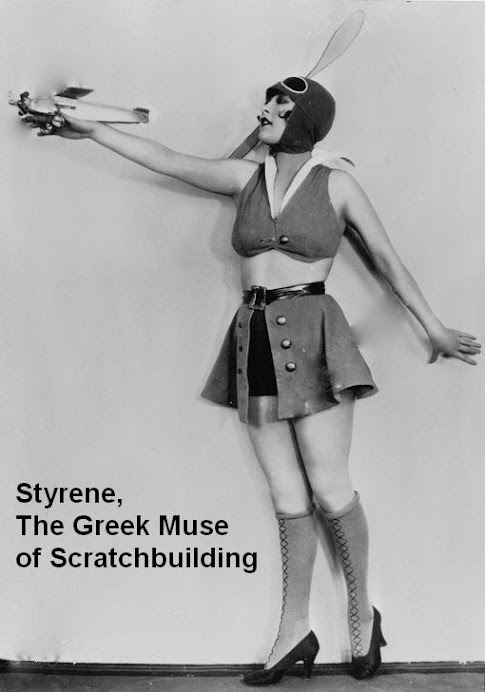Here is Liberty, the Bellanca J-300 flown non-stop by Hillis and Hoiriis on June 24/25 1931 from Grace Harbor, Newfoundland, to Germany and then Denmark.
The peculiarities of the Dora Wing kit can be found in the step-by-step building article here:
https://wingsofintent.blogspot.com/2021/01/modified-dora-wings-bellanca-j-300.html
But, as an advance, this is what it was modified:
- Replacement of the kit's engine version for the
correspondent version aftermarket item for this particular plane (Khee-Kha Art Products Wright resin engine and exhaust)
- Replacement of fuselage air scoops for accurate home-made ones for this version
- Replacement of the two somewhat chunky Venturi for new ones in the right positions
- Addition of wing fuel tank battens and correction of fuel caps
- Replacement of simplified inductor compass for home-made one
- Removal of inaccurate wingtip nav lights and replacement for new ones, addition of missing nav lights to rudder
- Replacement of control columns for home-made ones
- Addition of home-made long-range fuselage fuel tank (not really visible once the model is built)
- Replacement of inaccurate landing gear legs and reinforcement struts for home-made ones
- Relocation of tailwheel to accurate position
- Addition of metal pins to wings and front struts to lock them firmly in place
- Correcting by sanding down excessive front fuselage top height
- Replacement of horizontal stabilizer struts for narrower home-made ones
- Addition of home-made fuselage bottom landing gear fairing
- New Pitot tube
And some of the kit Pros:
-Very nicely molded
-Complete boxing with decals, photo-etched parts, masks and resin if appropriate (not for Liberty, only on Cape Cod boxing)
-Many parts for the spares bin as the sprues cater for many versions
-Nicely printed instructions, but with some mistakes and missing color callouts
-Contents well protected
-Very clear transparencies
-Nice level of detail regarding parts' complexity and surfaces
-Very desirable subjects
-Very little flash
-Fit fair in general, although requires some minor adjusting
And Cons:
-A not small quantity of minor inaccuracies that the modeler has to sort out, as the manufacturer's research was not detail-oriented and missed clear and visible differences amongst the versions/boxings offered
-Some inaccuracies in a couple of the paint schemes offered
-Some inaccuracies in the decals
-Locating devices sometimes weak or non-existent
-Top fuselage front strangely molded too thick/tall, unlike photos of the real planes.
-A bit of molding mismatch in some parts
Colors:
Based on the careful study and comparison of all the photos I have of Liberty, and noticing in them these characteristics:
a) That white objects compared to the fuselage surface -excluding nose- look clearly much "whiter" than it, thus it's unlikely that the general fuselage would be white
b) That the white in both flags, American and Danish, looks again "whiter" than the fuselage background
c) That photos of known red planes render in general a darker hue than the photos of Liberty's flying surfaces
d) That blue flying surfaces, as chosen by the kit maker, are a very unlike contrasting color for an ocean-spanning flight, where aposematic colors are highly desirable
e) That is visible in some of the photos a difference in hue between nose and flying surfaces
Thus it was concluded (personal choice, of course):
To represent the fuselage in white aluminium, a color sometimes used too by the French, that is frequently described also as white in contemporary accounts (as it is Liberty).
To represent the flying surfaces in a high-vis color, red-orange
To represent the nose in red
To represent the landing gear in metal color.
To represent the wing registrations in blue, as contrasting color to the wings, as it looks to me too light on photos to be black, and in this way matches the other blue marks in the kit's decals (Liberty and tail regs)
Even with its many issues, I enjoyed the building of this Dora Wings kit, but if you want a truly accurate replica, you have to put the extra work and extra research and make the necessary changes.
I am now in the process of building Cape Cod from another Dora Wing boxing.










































Faithful colour representation: a busy minefield for anyone who earnestly wishes to close in on it. My classic goto illustration for anyone who thinks their interpretation might be correct (and they might initially well be) is the museum in Prague(?) that houses the Anatra Anasal biplane, from on high.
ReplyDeleteMany photos of it on the net show it in a distinct grey green hue, sort of an RLM thing. Walk around the balustrade though, and it is very very obviously a tan-like clear doped linen.
Anyroad, yet another very attractive piece of confetto for your airfield.
"Modeling is the science of the impossible"
DeleteStyrenedes, Greek philosopher and olive pitter, VI century B.S.
As a descendant of Holger Hoiriis the pilot, I enjoyed you model!
ReplyDeleteGlad you enjoyed it, Mike! A nice family history!
Delete